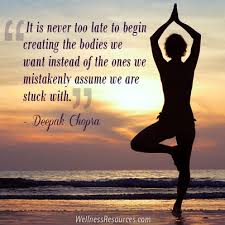
8 Fantastic Ways to Boost Your Energy Levels
We all know how important it is to get plenty of exercise, both for health and for weight loss. Unfortunately, many of us don’t get as much exercise as we know we should. Maybe you are just too busy to work a regular exercise program into your day but too often the reason for skipping an exercise workout is that you just don’t have enough energy to motivate you. Some of us feel as though we have no energy from the time we get up in the morning while others seem to experience a mid-day slump. If all you need to get you up and moving is a boost to your energy level, then here are eight fantastic ways to turn up the momentum.1. Eat more often. Instead of having three regular meals each day, break your food consumption down to six smaller meals. Your loss of energy may be due to drops in blood sugar in between meals. Eating more often will stabilize your glucose levels and give your energy levels a boost.2. Take up meditation or yoga or any other method of relaxation. Stress and depression can be at the root of a lagging energy drive. Take a few minutes to meditate before a big meeting or do thirty minutes of yoga every evening in order to wind down. Getting rid of anxiety can keep stressful situations from zapping your energy.3. Make some necessary lifestyle changes. Drinking alcohol and using tobacco are both habits that will deplete your body of nutrients and drain your energy. Alcohol can also cause dehydration which is one of the worst energy drainers of all and it can prevent you from getting the deep sleep you need to wake up feeling energetic.
4. Get a thyroid test. If you are frequently feeling tired even after a restful night’s sleep, you may have hypothyroidism. A simple blood test can determine this for sure. Women are more likely to have under-active thyroid problems than men, especially those who have just given birth or are nearing menopause.
5. Add more whole grains to your diet in place of sugar. This is another way to balance your glucose levels instead of having energy highs and lows as your sugar goes up and then drops as insulin is released in response. Skip the fruit pastries for breakfast and choose a whole grain muffin instead. Choose whole wheat for your sandwiches instead of white bread or buns and you will also add more fiber to your diet which most of us don’t get enough of.
6. Take a walk or take a nap. Sometimes the activity of taking a midday walk is all it takes to wake up your body and actually increase your energy. For some people, a power nap in the middle of a day is the best way to feel refreshed and improve their energy level. Whichever one works best for you, take anywhere from ten to thirty minutes to make a significant difference for you.
7. Eat a wide variety of fresh fruits and vegetables every day. Different types of produce contain different vitamins and minerals that your body needs to function and to produce energy. Choose different colors of vegetables to get a little of everything.
8. Allow more time for sleep. Many people believe that they are just fine with six hours of sleep but they really need to sleep another hour or longer to get the amount of rest they need to function at their maximum potential. Just because you are in the habit of sleeping from 11pm to 5am doesn’t mean that is all the rest your body needs.
There are many natural, healthy ways to increase your energy including those listed here. Try these instead of turning to high caffeinated beverages and energy drinks to give you a boost that will only let you down in the end!
If you are looking for more information on ways to increase energy and live a more successful and fulfilling life, check out “Amazing Self“.
———
This article is brought to you courtesy of “Amazing Self“, a personal development system that offers powerful personal breakthroughs in creating and living your dream life.
Amazing Self isn’t one person’s opinion of what truly signifies greatness. In fact, it goes far beyond any self-improvement system you have ever seen before. Amazing Self has formed a team of renaissance people who are committed to your personal success, and harnessed their thoughts and minds for the recipe to life-changing excellence in each of the 4 main areas of personal development: health/weight loss, making money, relationships, and mindset.

*************************
 Questions and Answers
Questions and Answers

From the national PT organization
Physical therapists (PTs) are highly-educated, licensed health care professionals who can help patients reduce pain and improve or restore mobility – in many cases without expensive surgery and often reducing the need for long-term use of prescription medications and their side effects.
PTs examine each individual and develop a plan, using treatment techniques to promote the ability to move, reduce pain, restore function, and prevent disability. In addition, PTs work with individuals to prevent the loss of mobility before it occurs by developing fitness- and wellness-oriented programs for healthier and more active lifestyles.
Physical therapists provide care for people in a variety of settings, including hospitals, private practices, outpatient clinics, home health agencies, schools, sports and fitness facilities, work settings, and nursing homes. State licensure is required in each state in which a physical therapist practices.
All PTs must receive a graduate degree from an accredited physical therapist program before taking the national licensure examination that allows them to practice. The majority of programs offer the doctor of physical therapy (DPT) degree.
WHAT DO PHYSICAL THERAPISTS EARN?
More than 175,000 physical therapists are licensed in the U.S. Today. The median salary for a physical therapist is $80,000 depending on position, years of experience, degree of education, geographic location, and practice setting.
WHERE DO PHYSICAL THERAPISTS PRACTICE?
Although many physical therapists practice in hospitals, over 80 percent practice in:
- Outpatient clinics or offices
- Inpatient rehabilitation facilities
- Skilled nursing, extended care, or subacute facilities
- Homes
- Education or research centers
- Schools
- Hospices
- Industrial, workplace, or other occupational environments
- Fitness centers and sports training facilities
WHAT ARE THE EDUCATIONAL REQUIREMENTS FOR BECOMING A PT?
The minimum educational requirement is a post-baccalaureate degree from an accredited education program. While some programs offer a master’s degree, a growing majority of programs offer the Doctor of Physical Therapy (DPT) degree. Currently, 199 colleges and universities nationwide support 212 accredited professional physical therapist education programs; 96% now offer the DPT and the remaining programs are planning to convert.
WHAT ARE THE LICENSURE REQUIREMENTS FOR BECOMING A PT?
After graduation, candidates must pass a state-administered national exam. Other requirements for physical therapy practice vary from state to state according to physical therapy practice acts or state regulations governing physical therapy.
WHAT IS THE EMPLOYMENT OUTLOOK FOR PHYSICAL THERAPY?
According to the Bureau of Labor Statistics, employment of physical therapists is expected to grow by 30 percent from 2008 to 2018, much faster than the average for all occupations. According to the American Physical Therapy Association (APTA), with just a 0.2 percent unemployment rate,

1. A bachelor’s degree in one of the following;health and human development, health promotion, exercise science, exercise physiology, kinesiology, biomechanics, or health enhancement.
2. A reputable personal training certification, preferably from one of the following organizations; American Council on Exercise (ACE), American Council on Sports Medicine (ACSM), or the National Strength and Conditioning Association (NSCA).
If the don’t have a degree in one of the above fields, don’t even bother with them. First of all, most of the reputable certifications require you to have a degree. There are some certification groups that don’t require a degree and the training for certification is a joke. I have worked with a lot of personal trainers without degrees and people are not getting their money’s worth from them. In fact, some of their programming is down right dangerous.
Secondly, if they don’t have one of the degrees described above, they don’t have enough of a background in human anatomy and physiology, exercise physiology, kinesiology (movement science) or biomechanics to put you on anything more than a very, very basic program.
Lastly, if you do pick up a personal trainer with the above qualifications, don’t let them put you on any kind of diet program unless they have a Sports Nutrition certification through a valid group. I worked with a trainer who placed a man on the Atkins diet for 4 months. The man is now a Type 2 diabetic.

I would check out the local chapter of ASTD in Denver. As a member or even visitor, there are many benefits to getting involved. One, it’s one stop shopping to a personal network of professionals already in the types of positions you are interested in.
Two, they have monthly programs and workshops at a really low cost that will provide you the opportunity to learn and practice the skills of the trade.
Three, many of their volunteer opportunities will assist you in fattening up your resume with targeted and relevant experience. Also, they have good relationships with employers in Denver and will help you with finding a job.
—————————-
Free Report Reveals: How science-based yoga will give you back the energy of your Youth…
*****************************





